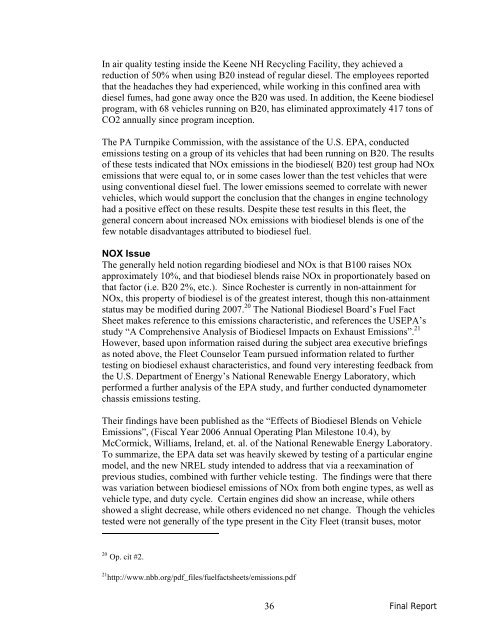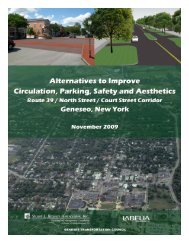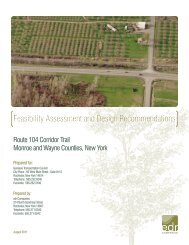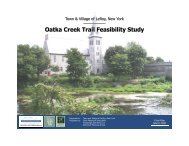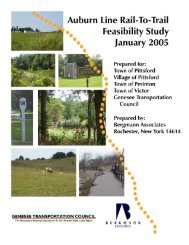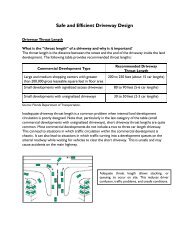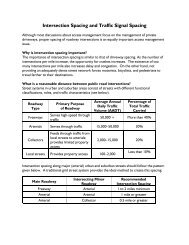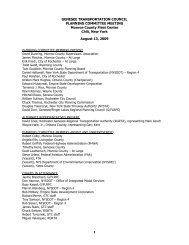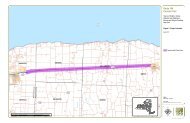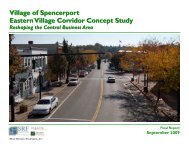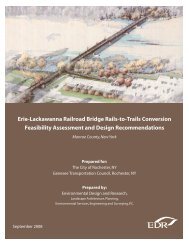Final Report Rochester Vehicle Fleet Alternative Fuels Systems Study
Final Report Rochester Vehicle Fleet Alternative Fuels Systems Study
Final Report Rochester Vehicle Fleet Alternative Fuels Systems Study
Create successful ePaper yourself
Turn your PDF publications into a flip-book with our unique Google optimized e-Paper software.
In air quality testing inside the Keene NH Recycling Facility, they achieved a<br />
reduction of 50% when using B20 instead of regular diesel. The employees reported<br />
that the headaches they had experienced, while working in this confined area with<br />
diesel fumes, had gone away once the B20 was used. In addition, the Keene biodiesel<br />
program, with 68 vehicles running on B20, has eliminated approximately 417 tons of<br />
CO2 annually since program inception.<br />
The PA Turnpike Commission, with the assistance of the U.S. EPA, conducted<br />
emissions testing on a group of its vehicles that had been running on B20. The results<br />
of these tests indicated that NOx emissions in the biodiesel( B20) test group had NOx<br />
emissions that were equal to, or in some cases lower than the test vehicles that were<br />
using conventional diesel fuel. The lower emissions seemed to correlate with newer<br />
vehicles, which would support the conclusion that the changes in engine technology<br />
had a positive effect on these results. Despite these test results in this fleet, the<br />
general concern about increased NOx emissions with biodiesel blends is one of the<br />
few notable disadvantages attributed to biodiesel fuel.<br />
NOX Issue<br />
The generally held notion regarding biodiesel and NOx is that B100 raises NOx<br />
approximately 10%, and that biodiesel blends raise NOx in proportionately based on<br />
that factor (i.e. B20 2%, etc.). Since <strong>Rochester</strong> is currently in non-attainment for<br />
NOx, this property of biodiesel is of the greatest interest, though this non-attainment<br />
status may be modified during 2007. 20 The National Biodiesel Board’s Fuel Fact<br />
Sheet makes reference to this emissions characteristic, and references the USEPA’s<br />
study “A Comprehensive Analysis of Biodiesel Impacts on Exhaust Emissions”. 21<br />
However, based upon information raised during the subject area executive briefings<br />
as noted above, the <strong>Fleet</strong> Counselor Team pursued information related to further<br />
testing on biodiesel exhaust characteristics, and found very interesting feedback from<br />
the U.S. Department of Energy’s National Renewable Energy Laboratory, which<br />
performed a further analysis of the EPA study, and further conducted dynamometer<br />
chassis emissions testing.<br />
Their findings have been published as the “Effects of Biodiesel Blends on <strong>Vehicle</strong><br />
Emissions”, (Fiscal Year 2006 Annual Operating Plan Milestone 10.4), by<br />
McCormick, Williams, Ireland, et. al. of the National Renewable Energy Laboratory.<br />
To summarize, the EPA data set was heavily skewed by testing of a particular engine<br />
model, and the new NREL study intended to address that via a reexamination of<br />
previous studies, combined with further vehicle testing. The findings were that there<br />
was variation between biodiesel emissions of NOx from both engine types, as well as<br />
vehicle type, and duty cycle. Certain engines did show an increase, while others<br />
showed a slight decrease, while others evidenced no net change. Though the vehicles<br />
tested were not generally of the type present in the City <strong>Fleet</strong> (transit buses, motor<br />
20<br />
Op. cit #2.<br />
21 http://www.nbb.org/pdf_files/fuelfactsheets/emissions.pdf<br />
36<br />
<strong>Final</strong> <strong>Report</strong>


